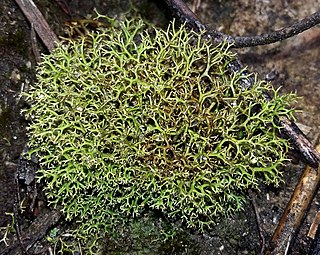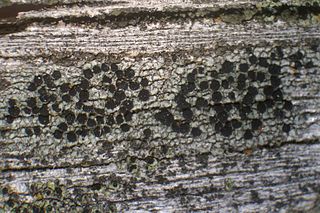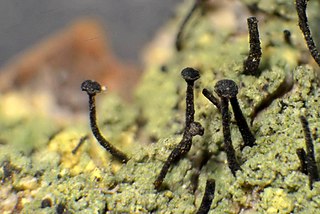
The National Herbarium of Victoria is one of Australia's earliest herbaria and the oldest scientific institution in Victoria. Its 1.5 million specimens of preserved plants, fungi and algae—collectively known as the State Botanical Collection of Victoria—comprise the largest herbarium collection in Australia and Oceania.

Cladia is a genus of lichenized fungi in the family Cladoniaceae. Cladia species have a crustose primary thallus and a fruticose, secondary thallus, often referred to as pseudopodetium. The type species of the genus, Cladia aggregata, is widely distributed, occurring from South America, South Africa, Australasia and South-East Asia to southern Japan and India. Most of the other species are found in the Southern Hemisphere.

Buellia is a genus of mostly lichen-forming fungi in the family Caliciaceae. The fungi are usually part of a crustose lichen. In this case, the lichen species is given the same name as the fungus. But members may also grow as parasites on lichens (lichenicolous). The algae in the lichen is always a member of the genus Trebouxia.
Redonia is a genus of lichenized fungi in the family Caliciaceae. It contains the single species Redonia chilena, a squamulose lichen. The type specimen was collected in Tarapacá, Chile, where it was found growing on calcareous soil. The genus was circumscribed in 1973 by Carroll William Dodge. The genus name honours Jorge Redón Figueroa, a Chilean lichenologist who collected the type.

Catolechia is a genus of lichen-forming fungi in the family Rhizocarpaceae. It is a monotypic genus, containing the single species Catolechia wahlenbergii. The genus was circumscribed by German botanist Julius von Flotow in 1850. He did not assign a type species for the genus; Catolechia pulchellaA.Massal. (1852) was designated as the type by Gustav Wilhelm Körber in 1855. This species is synonymous with Catolechia wahlenbergii.

The Caliciaceae are a family of mostly lichen-forming fungi belonging to the class Lecanoromycetes in the division Ascomycota. Although the family has had its classification changed several times throughout its taxonomic history, the use of modern molecular phylogenetic methods have helped to establish its current placement in the order Caliciales. Caliciaceae contains 36 genera and about 600 species. The largest genus is Buellia, with around 300 species; there are more than a dozen genera that contain only a single species.

Buellia spuria, the disc lichen, is a white to light ashy gray crustose areolate lichen that grows on rocks (epilithic) in montane habitats. It has a black edge from the conspicuous, more or less continuous prothallus, which can also be seen in the cracks between the areolas forming a hypothallus, and in sharp contrast with the whitish or ashy colored areolas. It prefers mafic (siliceous) rock substrates. In Joshua Tree National Park is can be seen on vertical granite and gneiss faces in washes. It is common worldwide in the Northern Hemisphere. It is very common in the Sonoran Desert from southern California to Arizona, Baja California, and Sonora, Chihuahua, and Sinaloa, Mexico.
Buellia asterella, commonly referred to as the starry breck lichen, is a rare, black and white lichen in the family Caliciaceae. Once found all across the central European grasslands, it was described as new to science in 1974. Today, it is classified by the IUCN Red List as Critically Endangered and only found in select regions in Norway and Germany.
Gintaras Kantvilas is an Australian lichenologist, who earned his Ph.D in 1985 from the University of Tasmania with a thesis entitled Studies on Tasmanian rainforest lichens. He has authored over 432 species names, and 167 genera in the field of mycology.
Rex Bertram Filson is an Australian lichenologist who made major contributions to knowledge of lichens in Australia and Antarctica.
Xanthoparmelia elixii is a lichen in the family Parmeliaceae, and found in South Australia.
Cladia beaugleholei is a lichen in the family Cladoniaceae, found in Australia. It was first described as Heterodea beaugleholei in 1978 by Rex Filson, from a specimen collected from forest soil in New South Wales. The species epithet honours Alexander Clifford Beauglehole. It was reassigned to the genus, Cladia by Sittiporn Parnmen and H. Thorsten Lumbsch in 2012.

Caliciales is an order of mostly lichenized fungi in the class Lecanoromycetes. It consists of two families: Caliciaceae and Physciaceae, which together contain 54 genera and more than 1200 species. The order was circumscribed by American botanist Charles Edwin Bessey in 1907.
Fluctua is a lichen genus in the family Caliciaceae. It is monotypic, containing the single crustose lichen species Fluctua megapotamica. The genus was circumscribed by Austrian lichenologist Bernhard Marbach in 2000. It was one of several segregate genera proposed by Marbach in his 2000 revision of American species of Buellia. The lichen is found in Brazil and Uruguay.

Schaereria is a genus of lichen-forming fungi. It is the sole genus in the family Schaereriaceae, which itself is the only family in the Schaereriales, an order in the subclass Ostropomycetidae of the class Lecanoromycetes. Most Schaereria species are crustose lichens that live on rocks. Schaereria was first proposed by Gustav Wilhelm Körber in 1855 and was later taken up by other lichenologists despite periods of disuse.

Buellia schaereri is a species of lichen in the family Caliciaceae. It was formally described as a new species in 1849 by Italian botanist Giuseppe De Notaris. The botanical name honours Swiss pastor and lichenologist Ludwig Schaerer. It is a widely distributed lichen, occurring in Africa, Asia, Northern and Central Europe, Macaronesia, Central America, and North America. It grows on the bark and wood of trees, especially conifers and oak.

Ciposia is a single-species fungal genus in the family Caliciaceae. Circumscribed by Bernhard Marbach in 2000, it contains the species Ciposia wheeleri, a corticolous (bark-dwelling) and crustose lichen. This species was originally classified in genus Buellia by Richard Harris in 1988.

Buellia frigida is a species of saxicolous (rock-dwelling), crustose lichen in the family Caliciaceae. It was first described from samples collected from the British National Antarctic Expedition of 1901–1904. It is endemic to maritime and continental Antarctica, where it is common and widespread, at altitudes up to about 2,000 m (6,600 ft). This resilient lichen has a characteristic appearance, typically featuring shades of grey and black divided into small polygonal patterns. The crusts can generally grow up to 7 cm in diameter, although neighbouring individuals may coalesce to form larger crusts. One of the defining characteristics of the lichen is a textured surface with deep cracks, creating the appearance of radiating lobes. These lobes, bordered by shallower fissures, give the lichen a unique visual texture.

Usnea sphacelata is a species of saxicolous (rock-dwelling), fruticose lichen in the large family Parmeliaceae. It is found in both polar regions of Earth, as well as in southern and northern South America and in New Zealand.











